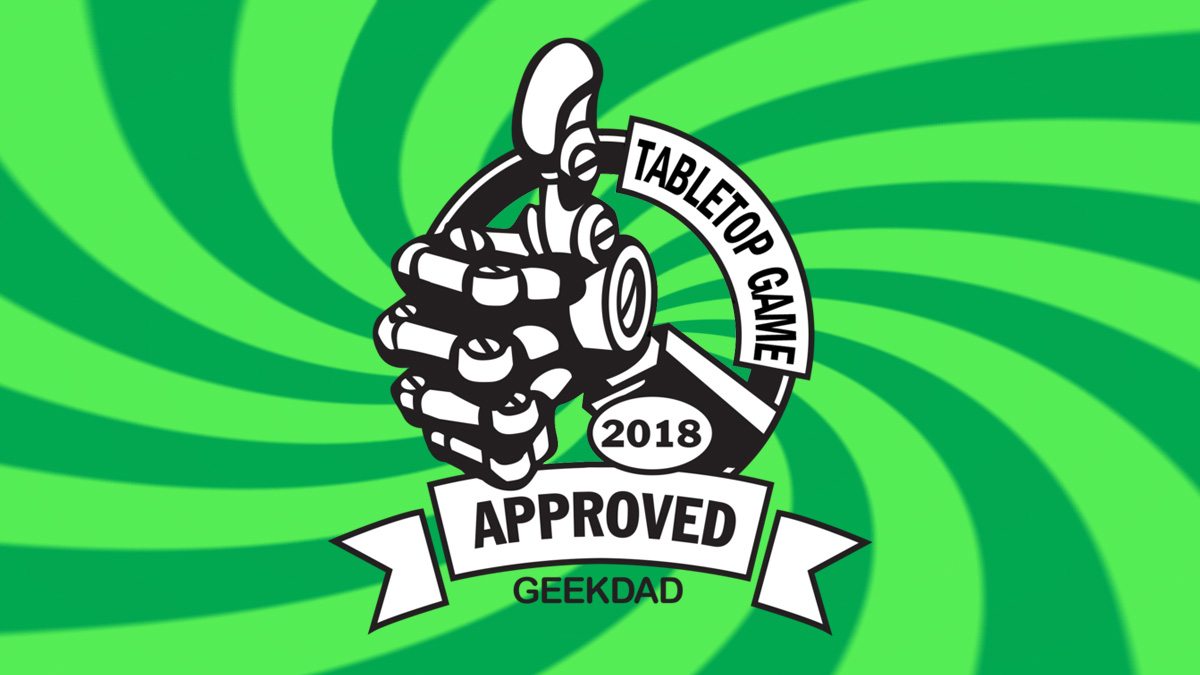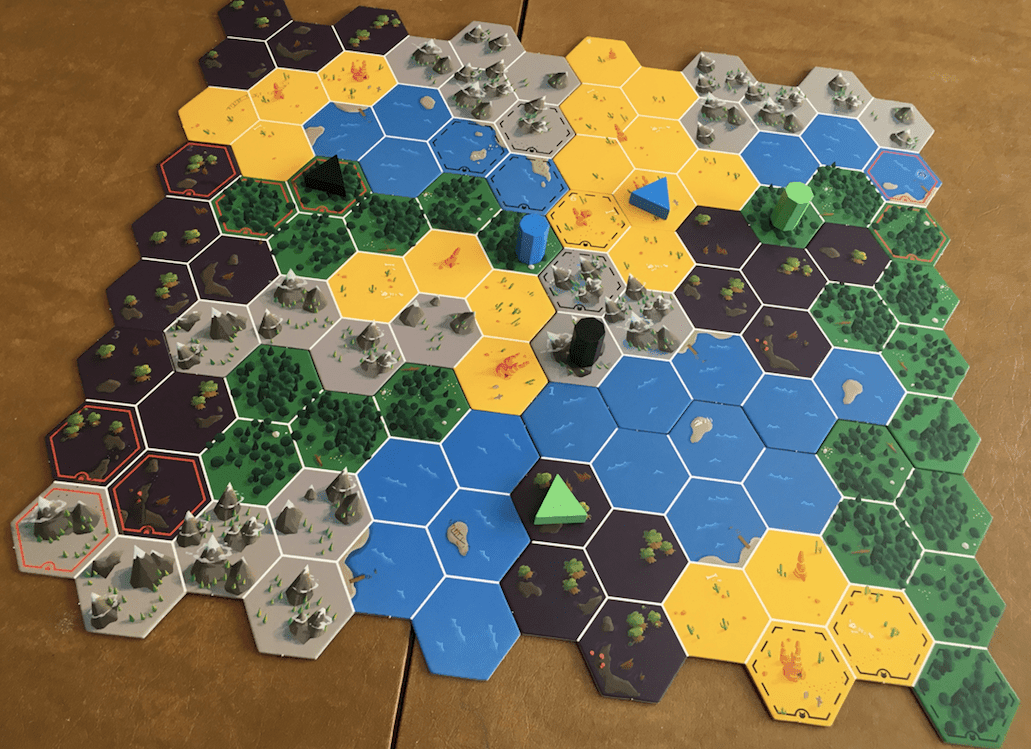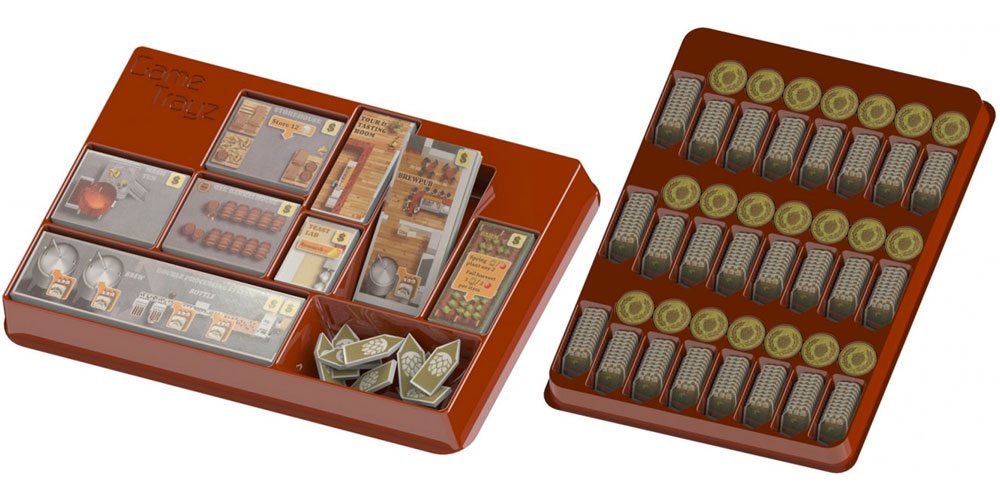What Is Cryptid?
Cryptidis a 3-to-5-player game from Osprey Games that has players searching for an elusive creature that the Oxford English Dictionary defines as:
an animal whose existence or survival to the present day is disputed or unsubstantiated; any animal of interest to a cryptozoologist.
Each player takes on the role of a cryptozoologist who possesses a little knowledge about the location of the creature… but not all. The combined knowledge of each player will reveal the location, but who wants to share the credit for discovering it? Through careful deduction and strategy, you may be able to determine the location of the creature before your fellow researchers and bask in the glory of discovering the find of the century.
Note: This review is based on a review copy I was provided by Osprey Games.
Cryptid Components
The Cryptid game box includes the following components:
- 6x numbered Map tiles
- 4x Standing Stones (octagon shape)
- 4x Abandoned Shacks (triangle shape)
- 1x Pawn
- 5x Player Token Sets (cubes and discs of the same color)
- 5x Player Clue Books
- 54x Game Cards
- 1x Rulebook (12 pages)
The box is made from high-quality materials—very heavy and solid and everything fits nicely inside with the provided trays. The tokens are wood and of sufficient size for easy handling. Colors on the Map tiles are bright and vivid, with easily distinguishable colors for the different types of terrain. The Rulebook and Clue Books are designed to mimic researcher journals (each has a unique color but also a Greek symbol), and the inside graphics match the theme of the game. A Quick Reference is provided on the back of the Rulebook, and each player’s Clue Book has an explanation of the various types of possible clues on the back of the book.
How to Play Cryptid
Objective
Players will try and be the first to locate the creature by asking questions of fellow researchers that help narrow down its unique location on six numbered Map tiles. Each player will be provided a single clue (each player’s Clue Book contains a total of 96 clues) that they must keep secret. Using the placement of tokens and deduction, players will rule out locations on the map and zero in on certain terrains or distances from landmarks to determine the final location of the cryptid.
Cryptid is GeekDad Approved!
Setup
There are two modes for Cryptid—Normal and Advanced. Normal mode provides an easier game for younger players with fewer tokens in play for a slightly faster game and the removal of negative clues such as “the habitat is not near water.” The Advanced game increases the complexity by using all four types of structures (versus three in the Normal game) and allows for both positive and negative clues. Positive and Negative doesn’t mean a player can lie—it simply means that certain clues will eliminate or support smaller subsets of the entire Map.
Note: Consider if my clue to the location of a person in the USA ”is not in Florida”—a Negative clue—that leaves a much larger set of possible locales (49 states). But if the game only allows Positive clues, my clue would be the person “is in Texas.” A much more powerful clue.
Once you’ve decided on the mode of your game, you have two choices for setup—use the online tool (playcryptid.com) or use the included Clue Books, one per player. If you choose to use the online tool, select the number of players, the mode of the game, and it will provide the correct layout of the six numbered Map tiles and a single clue for each player. (Each map tile has a number in its upper-left corner.) If a player forgets his/her clue or just wishes to verify before answering a question, the online tool will allow a player to view the clue again.
If you’re not using the online tool, you’ll need to separate the Game Cards. Use the black bordered Game Cards if you’re playing an Advanced mode game. Use the clear bordered Game Cards for a Normal mode game. Shuffle the correct Game Cards and draw ONE card. One side of the card will show you the proper placement of the six Map tiles. The flip-side of the card provides a small chart—determine the number of players (3, 4, or 5) using the left-most column. The other four columns are colored (and have a symbol)—use that color/symbol to reference the single clue that will be used from the matching Clue Book. For example, using the image below, a five-player game will use the following clue books: Alpha, Beta, Gamma, Delta book, and Epsilon. (The back of the clue book also contains a rules summary for the possible clues and how to interpret them as well as rules related to spaces and a map key.) The card also provides the number for a specific HINT (hints are found in the Rulebook and a Reveal Hint button on the online tool will provide it as well) that players may choose to use if the game gets too difficult.
If you’ve performed the setup properly, there is only ONE possible space for the Cryptid location based on the player clues and the correct placement and orientation of the six Map tiles.
Before each player begins their turn, there is one final setup task. Choose a Starting Player. That player will place one of his/her colored Cube tokens on a space on the board which could NOT be the cryptid’s habitat based on his/her clue. Play proceeds clockwise, with each player placing two of their colored cubes on the board in spaces that their clue eliminates as possible habitats. Players can place a Cube token on a space with a Structure token (triangle or octagon) but not on a space containing another player’s Cube token. Once two Cube tokens per player are placed, player turns can begin.
NOTE: During the game, Cube tokens will occupy spaces that CANNOT be the cryptid’s habitat. Disc tokens will occupy spaces that COULD be the cryptid’s possible habitat.
Your Turn
One of two actions may be taken on a player’s turn:
- Ask another player a question OR
- Search a space
When you ask a question, you place the Pawn on a space and choose a player to ask “Is it possible the creature could be here?” The player responding MUST say Yes or No based on the clue they are using from their Clue Book. That player MUST also place either a disc or cube (matching that player’s color). If the player places a disc (indicating a YES/POSSIBLE answer), the play passes to the next player (clockwise).
If that player instead places a cube (to indicate that location is not possible based on his/her clue), the player asking the question MUST also place a cube on a legal space (without a token) that COULD be the location based on his/her question. Got it? The clues in the Clue Books and the gameboard arrangements have been structured in such a way that the Cryptid can ONLY be on a single spot if all clues are properly (and honestly) used to provide answers.
Searching is the second action you may take. This involves placing the Pawn AND one of your discs on a space that you believe is the proper location of the Cryptid. Moving clockwise, all other players must respond Yes or No and place a cube or disc on the space unless they already have a disc there (and then they pass to the next player). If any player places a cube, the Search round stops and any remaining players who have not responded do not respond. You must place a cube on a different space using your clue and your turn is over.
Errors and Clues
The game does provide for some assistance in the form of Hints… and there is a rule for how to handle when a player accidentally makes a mistake and places a disc and/or cube incorrectly. (Members of your gaming group would NEVER do this on purpose, right?) If a hint is needed, all three players must agree or all-but-one in a four or five player game. On the selected card that showed where to place the Map tiles is a single number in the last column (different number based on how many players). Consult that number on pages 9-10 of the Rulebook for a single clue.
Winning
If during your Search a cube is NOT placed, this means all other players are answering YES (and discs are placed) and YOU WIN… you found the Cryptid!
Why You Should Play Cryptid
I’ve now played the game three times. Won once, lost twice. What I enjoy most about the game is the deduction aspect, with the deception part coming in a close second. By deception, I don’t mean lying… I mean misleading in an HONEST manner. You are not given much leeway in how you respond to the “Could it be here?” question, but your own placement of tokens can be used to mislead… this will become apparent once you play a game.
The sheer volume of clues and cards points to the replayability of the game, and that’s another key aspect. If you play with a regular group, you can easily remove a card once you’ve used it to ensure you never play that Cryptid location again, but this does mean that the card deck will eventually run out—but I don’t know if I’ve ever played 54 games of ANYTHING in my life…
Cryptid is a beautiful game—it would definitely catch my eye if I saw it open and being played. The quality of the box and all the components is outstanding, and I didn’t spot any errors in the instructions.
I do believe this game will be best played with friends and family. There’s an honesty policy in place with this game, and you’ve got to trust that all other players are responding truthfully or the game breaks. There is a rule in place to handle when someone makes an unintentional mistake, but if someone wants to sabotage the game and just be an @#$@#$, this is certainly possible. If you trust the other players (and I did), the game is very enjoyable as you race to see who can deduce the location the fastest.
I saw the game at Gen Con but didn’t get to play. Now that I’ve got a small number of games under my belt, I’m excited to introduce this to more players. I’ve played games that were based on deduction, but this one has a really unique feel to it… just like trying to discover a unique creature, Cryptid feels like discovering a new style of game.
Note: I’d like to thank Christian at Osprey Games for providing me with a review copy of Cryptid. The game is out now.








